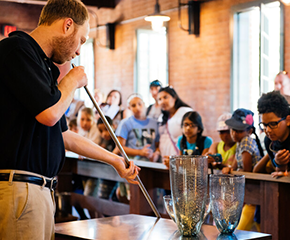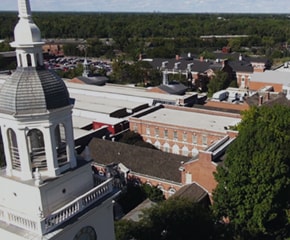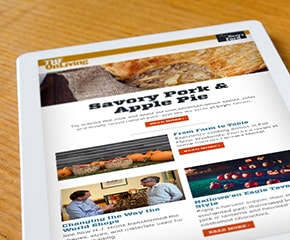
Curators' Choice: Transportation
25 artifacts in this set
This expert set is brought to you by:
The staff at The Henry Ford
1896 Ford Quadricycle Runabout, First Car Built by Henry Ford
Automobile
The Quadricycle was Henry Ford's first attempt to build a gasoline-powered automobile. It utilized commonly available materials: angle iron for the frame, a leather belt and chain drive for the transmission, and a buggy seat. Ford had to devise his own ignition system. He sold his Quadricycle for $200, then used the money to build his second car.
1928 Ford 4-AT-B Tri-Motor Airplane, "Floyd Bennett," Flown Over the South Pole by Richard E. Byrd
Airplane
The Ford Tri-Motor was the most popular airliner of the late 1920s and early 1930s. Its rugged dependability led Richard Byrd to choose a Tri-Motor for his attempt to be the first person to fly over the South Pole. On November 28-29, 1929, Byrd and a crew of three achieved that goal in this plane.
1891 Abbot Downing Concord Coach
Concord coach
The stagecoach is a symbol of the American West, but its origins are in New England. First built in the 1820s, Concord coaches featured an innovative leather-strap suspension that produced a rocking motion over rough roads -- easier on passengers and horses alike. This example carried passengers and mail in New Hampshire and Maine before the automobile made it obsolete.
Steam Locomotive "Sam Hill," 1858
Steam locomotive
This 1858 Rogers steam locomotive is typical of those used in the United States in the second half of the 19th century. Its flexible wheel arrangement, high power output, and light weight were well suited to the tight curves, steep grades, and hastily constructed track that characterized American railroads. This locomotive struck an agreeable balance between practicality, safety, and economy.
Hildebrand & Wolfmuller Motorcycle, circa 1894
Motorcycle
The German-built Hildebrand & Wolfmuller motorcycle was the first motorized, two-wheeled vehicle sold to the public on a series production basis. Hildebrand & Wolfmuller was also the first company to refer to the device as a "motorcycle" (though it used the German word, motorrad). The curious engine design features two cylinders with connecting rods attached directly to the rear wheel.
Pope Columbia Safety Bicycle, 1889
Bicycle
New "safety" bicycles, like this Pope Columbia, touched off a bicycle craze in the 1880s and 1890s. More stable with two same-sized wheels and less expensive than the high-wheeled "ordinaries," safety bicycles allowed many Americans to discover the sheer joy of riding.
1939 Sikorsky VS-300A Helicopter
Helicopter
Igor Sikorsky, as a young man in Russia, tried unsuccessfully to build a helicopter in 1909. He went on to build fixed-wing aircraft but returned to helicopters in 1938. Within three years, he had developed the first practical helicopter in the United States: the VS-300A.
Allegheny Steam Locomotive, 1941
Steam locomotive
The Chesapeake & Ohio Railway's massive Allegheny, introduced in 1941, represents the peak of steam railroad technology. Among the largest and most powerful steam locomotives ever built, it weighed 1.2 million pounds with its tender and could generate 7,500 horsepower. Just 11 years later, C&O began pulling these giants from service. Diesel-electric locomotives proved more flexible and less expensive.
1931 Bugatti Type 41 Royale Convertible
Automobile
Longer than a Duesenberg. Twice the horsepower of a Rolls-Royce. More costly than both put together. The Bugatti Royale was the ultimate automobile, making its owners feel like kings. Not only did it do everything on a grander scale than the world's other great luxury cars, it was also rare. Bugatti built only six Royales, whereas there were 481 Model J Duesenbergs and 1,767 Phantom II Rolls-Royces.
1965 Ford Mustang Convertible, Serial Number One
Automobile
It's an old auto industry cliche -- "you can't sell a young man an old man's car, but you can sell an old man a young man's car." It's also true. The sporty Mustang was a young man's -- and woman's -- car. The under-30 crowd loved it. But older people also bought them, often as a second car. The Mustang hit a sweet spot in the market, appealing to a wide range of buyers.
1914 Ford Model T Touring Car, Given to John Burroughs by Henry Ford
Automobile
This 1914 touring car is one of several Model T automobiles given to naturalist John Burroughs by his friend Henry Ford. Ford Motor Company experienced a milestone year in 1914. The automaker fully implemented the moving assembly line at its Highland Park plant, and it introduced the Five Dollar Day profit-sharing plan for its employees.
1896 Duryea Runabout
Automobile
Early automobile inventors tended to make one-of-a-kind vehicles. Charles and Frank Duryea had a different idea. In 1896, they established the Duryea Motor Wagon Company and built thirteen identical vehicles. Based on their second model that had recently won America's first automobile race, this car was user friendly. A single lever controlled steering, shifting, and accelerating. The Henry Ford owns the only known surviving 1896 Duryea.
1939 Douglas DC-3 Airplane
Airplane
The Douglas DC-3, introduced in 1936, carried 21 passengers -- enough to fly profitably without relying on subsidies from air mail contracts. While the DC-3's economy appealed to airlines, its rugged construction and comfortable cabin attracted passengers. More than any other aircraft, the DC-3 ushered in the era of dependable, long-distance air travel in the United States.
1961 Lincoln Continental Presidential Limousine Used by John F. Kennedy
Automobile
President John F. Kennedy was assassinated in this car on November 22, 1963. The midnight blue, un-armored convertible was rebuilt with a permanent roof, titanium armor plating, and more somber black paint. The limousine returned to the White House and remained in service until 1977. The modified car shows the fundamental ways in which presidential security changed after Kennedy's death.
1949 Volkswagen Sedan
Automobile
The Volkswagen Beetle was different from any American car. It looked like an insect, its engine was where the trunk should be, and it didn't have a radiator. But it recalled the spirit of Henry Ford's legendary Model T. Both cars were simple, reliable, economical, and never deviated from their basic original design. The VW would go on to break the Ford's all-time sales record.
1960 Chevrolet Corvair Sedan
Automobile
With its rear-mounted, air-cooled engine, the Corvair was conceived as an American answer to the rear-engined, air-cooled Volkswagen Beetle. Corvairs sold well, although not as well as the more conventional Ford Falcon. But sales slipped after Ralph Nader's book, Unsafe at Any Speed, raised questions about the Corvair's handling. Production ceased in 1969.
Noyes Piano Box Buggy, circa 1910
Buggy (Carriage)
Factory-built buggies made the pleasures of carriage ownership affordable for a new group of people. Whether in town or on the farm, people loved these inexpensive, lightweight vehicles. The piano box buggy -- named for its resemblance to 19th-century square pianos -- was the most popular of all. Buggy owners quickly became accustomed to the freedom and control offered by personal vehicles.
1943 Willys-Overland Jeep Runabout
Military vehicle
World War II produced one of America's all-time favorite vehicles -- the jeep. Soldiers loved the homely little car because it could go anywhere and do almost anything. They used it to tow artillery, carry the wounded, and deliver ammunition. When fitted with a machine gun, it became a weapon itself. The jeep came to symbolize American ingenuity and productivity to allies and enemies alike.
1924 Railroad Refrigerator Car, Used by Fruit Growers Express
Refrigerator car
Modern refrigerated rail cars have mechanical cooling units, but well into the 20th century, ice cooled refrigerator cars like this one. Since 45-55 pounds of ice melted each hour, icing stations had to be located at regular intervals along the route, and adherence to strict schedules was necessary to prevent spoilage. The ability to ship meats and produce in refrigerator cars, far from their points of origin, greatly expanded both farmers'...
1952 Federal 45M Truck Tractor, Used by Cole's Express
Truck tractor
When this truck was new, about 120,000 tractor-trailers traveled the roads. By 2000, there were over two million. New interstate highways helped long-haul trucks dominate the freight business. Americans developed a romantic image of truckers as modern cowboys roaming concrete trails, speaking their own language on CB radios. Drivers became heroes of movies and music. But real truck driving is demanding, sometimes dangerous, and often boring work.
1981 Checker Marathon Taxicab
Taxicab
Most people think of Checker as an operator of taxicabs, but from 1922 through 1982 they also manufactured cabs. Checkers featured big back seats and trunks and rugged, durable construction. This Checker's basic design dates to 1956 and was substantially unchanged until production ceased in 1982.
1957 De Soto Fireflite Hardtop
Automobile
De Soto appealed to drivers who desired the cutting edge of technology. Soaring fins and an airy roof suggested military jet fighters. Pushbuttons replaced old-fashioned transmission levers. And De Sotos were powerful -- perfect for the new high-speed, four-lane turnpikes and the newly funded interstate highway system.
1906 Locomobile "Old 16" Race Car
Racing car
In 1908, driver George Robertson and mechanician Glenn Ethridge took this car to victory in the Vanderbilt Cup, America's first great automobile race. It marked the first time an American-built car won a major international road-circuit race. The Locomobile competed while wearing race number 16, and it's been known as "Old 16" ever since.
1965 Goldenrod Land Speed Race Car
Racing car
On November 12, 1965, Goldenrod streaked across Utah's Bonneville Salt Flats at 409.277 miles per hour, setting a new land speed record for wheel-driven cars. Builders Bob and Bill Summers powered Goldenrod with four massive Chrysler V-8 engines. Although other car builders copied its sleek design, Goldenrod held the record until 1991.
1989 Honda Accord DX Sedan
Automobile
Honda introduced its Accord in 1976 as a compact car. It was economical, well-built, and fun to drive. Over the years Accords got bigger, and by 1989 they could accommodate families. In 1989 Accord became the first Japanese nameplate to become the bestselling car in the United States. Ironically, many Accords, including this one, were built at Honda's plant in Marysville, Ohio.


